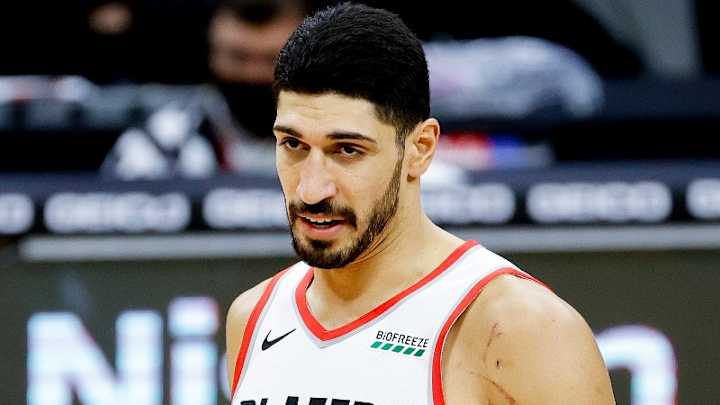Film Room: The Defensive Ripples of Protecting Enes Kanter

There isn't a more limited offensive team in basketball than the short-handed Orlando Magic. Steve Clifford's team wasn't exactly teeming with dynamic offensive players before Markelle Fultz tore his ACL in January, and was even more punchless on Tuesday night playing without Aaron Gordon and Evan Fournier.
The result was a respite of sorts for the Portland Trail Blazers, who entered their 106-97 victory over Orlando victory owning the third-worst defensive rating in the league. The Magic struggled from the field, three-point range and free-throw line on Tuesday en route to a dismal 100.0 offensive rating.
The Blazers, especially an extra disruptive Robert Covington, deserve some credit for their opponent's stark inefficiency, but it's telling that the Magic's effort wasn't even close to their worst of the season. Orlando has put up an offensive rating below triple digits in a whopping seven games so far.
The defensive deficiencies of individual players in Portland's rotation are nearly as numerous as they are obvious. But Enes Kanter's loom largest in gameplans and in-game adjustments, a reality on full display–even if it didn't always result in a score for the Magic–when facing arguably the worst offense in the NBA.
In our pregame primer, we touched on the challenge that Nikola Vucevic's evolution into a true stretch five would pose to not just the Blazers at large, but Kanter specifically.
Terry Stotts indeed deployed two different defensive strategies against Vucevic depending on whether Kanter was in the game. Content to bust out 2-3 zone, double-team the post and play more basic help principles during Harry Giles' stint and with Covington moonlighting at center, Portland otherwise used a more radical and debilitating defensive approach.
Check out the possession below, which ends with Cole Anthony hitting an easy jumper with Kanter slow to close.
See Kanter, Damian Lillard, Covington and Derrick Jones Jr. almost simultaneously point for a switch as Vucevic prepares to set a ball screen for Anthony? The Blazers' main goal from switching, as was the case all night, is to prevent Vucevic from stepping behind the three-point line for an open jumper.
Few bigs in the league are fast enough to execute ICE coverage on side ball screens, then scurry back to the arc in time to get an effective contest on a popping screener. None can do it effectively without the help of an aggressive dig from the opposite wing, and that's the other thing this coverage is designed to prevent – weak-side rotations that put Kanter and the Blazers in a full-on scramble.
Surrendering an open, non-paint two to Anthony makes that easier, and so does Orlando's action taking place on the side of the floor with an empty corner.
The pick-and-roll between James Ennis and Vucevic below comes with the court more balanced. Derrick Jones Jr. is a step late on the switch, prompting rotations from Lillard and Covington as Vucevic catches on the roll.
This sequence results in the Magic inbounding from the baseline, a fine result Portland, but it's the process that's the point.
The need to switch onto a non-threat like Ennis in ball-screen action lays the Blazers' lack of confidence in Kanter bare. Most centers would have enough time to meet Ennis near the elbow extended and get back to Vucevic at the key without giving up a wide-open jumper. But Kanter is notably slow of both foot and defensive decision-making, a blend of weaknesses that forces Portland into relying on a bad pass from Vucevic to successfully defend a play that should have been far easier to stop.
Reminder: Every action NBA offenses run is meant to produce an open shot as much as it is to coax rotate from the defense. Even when the Blazers scramble with speed and precision on the back end, they'd still rather have avoided the need to do it.
On this possession, Kanter switches onto Dwayne Bacon after a simple drag screen from Vucevic in transition, leaving Lillard to bang with Vucevic on the block.
Jones sees it the whole way and quickly takes Vucevic, bumping Lillard out to Ennis–called a "scram" switch. The problem? Vucevic still has a mismatch in the post at his eventual catch, prompting a double-team he exploits with a cross-court kick to Bacon for three.
Orlando can live with that shot, and Portland can certainly live with giving it up. But what about come playoff time, when it's Paul George instead of Bacon? Or the previous possession, when LeBron James and Anthony Davis replace Ennis and Vucevic?
Stotts may very well have instructed Kanter to switch ball screens set by Vucevic because he knew the Magic's depleted supporting cast would most often fail to take advantage. If so, he wasn't wrong; Orlando never found a rhythm offensively, and Vucevic went 2-of-7 from deep.
It's not at all guaranteed, basically, that Portland opts for the same strategy the next time they face a center who shoots like a guard.
But it's damning of Kanter's weaknesses nonetheless that the Blazers felt the need to employ it, and more importantly, a reminder of just how readily exploitable he–and at least one other Portland rotation player–will be under the postseason pressure cooker.
